|
|
|
|
|
|
Camouflage System - 1943 to 1945
|
|
|
|
|
|
|
|
With the A.H.M. 1943, Blatt 5 from 22nd February 1943, No. 181 (O.K.H. (Ch d H Rüst u. BdE), 18th February 1943 - 72/88/1 - In 2 (V)), the coating of the equipment was totally new regulated. In place of the dark-grey/dark-brown coating, which was changed to dark-grey only for the duration of the war, and the brown/grey coating for equipment used in Africa and Crete, the new coating of Dunkelgelb nach Muster (dark yellow after sample) was introduced with immediate effect. The exact RAL hue should be announced at a later date. The previous camouflage coat should be used for small items of equipment like boxes until further notice. The camouflage finish should now be made by the troop itself. It should be freely combined with the three Tarnpasten (camouflage pastes) of the shades Dunkelgelb nach Muster, Rotbraun (red-brown) RAL 8017 (today Schokoladenbraun – chocolate brown – RAL 8017) and Olivgrün nach Farbtonkasten des RLM für Tarnfarben (olive-green of the colour box of the RLM for camouflage colours). Newly produced equipment and equipment in army ordnance depots hat to be repainted. Equipment of field units should not be repainted. A necessary camouflage should be done by using the three mentioned Tarnpasten. With A.H.M. 1943, Blatt 9 from 7th April 1943, No. 322 (O.K.H. (Ch H Rüst u. BdE), 3rd April 1943 - 72/88/16 - In 2 (V)) it was intimated that the shades Olivgrün nach Farbtonkasten des RLM für Tarnfarben and Dunkelgelb nach Muster were accepted to the RAL Farbtonregister (colour shade register) 840 R. The shade Olivgrün nach Farbtonkasten des RLM für Tarnfarben was now designated Olivgrün (olive green) RAL 6003 and the shade Dunkelgelb nach Muster got the new designation Dunkelgelb (dark yellow) RAL 7028. But the hue RAL 6003 was part of the RAL-Farbtonregister before. It was very similar to the hue Olivgrün nach Farbtonkasten des RLM für Tarnfarben but was less yellowish. The first stock of camouflage pastes which were dispensed in early summer 1943 corresponds to the hue of the Luftwaffe while the later dispersed pastes corresponds to the hue RAL 6003 from the RAL-Farbtonregister. The shade Dunkelgelb RAL 7028 was the base colour of the camouflage system to at least autumn 1944.
Until summer 1943, the new camouflage coating was implemented to a large extent. This was possible because, for example, it came to a longer silent period on the eastern front between the heavy winter fights and the planned summer offensive which was used for extensive maintenance and overhaul of the equipment. After larger overhaul works, the camouflage coat of the equipment was renewed. In many cases, only a camouflage coat of the mentioned Tarnpasten was applied over the darg-grey base colour which was very effective, too. In th Ht.V.Bl. 1943, 2. Ausg. from 15th May 1943, No. 39, it was pointed out that the new coating according to the A.H.M. 1943, No. 181 was to be used only for vehicles of the frontline army. Vehicles of the reserve army should first be repainted when the coating hat to be renewed anyway. Later, the dark-yellow colour was not only used for major item of equipment. Other articles of equipment like ammunition crates, helmets, mess kits etc. were painted in dark-yellow, too. The Wehrmacht got its typical appearance of the second half of war due to the dark-yellow shades.
|
|
|
|
|
|
|
|
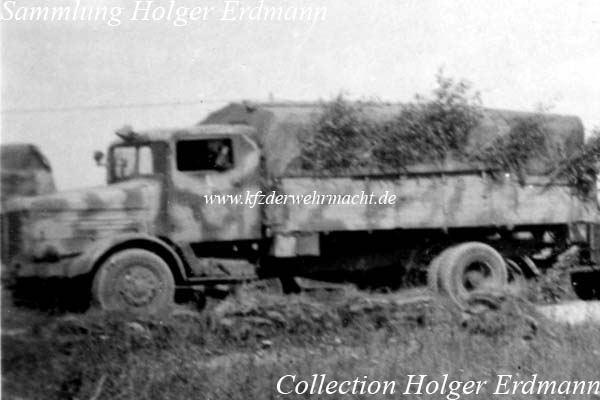 This Büssing-NAG 500 A was photographed in spring 1943. The dark-yellow RAL 7028 colour was painted as camouflage colour over the dark-gray base colour. This Büssing-NAG 500 A was photographed in spring 1943. The dark-yellow RAL 7028 colour was painted as camouflage colour over the dark-gray base colour.
|
|
|
|
|
|
|
|
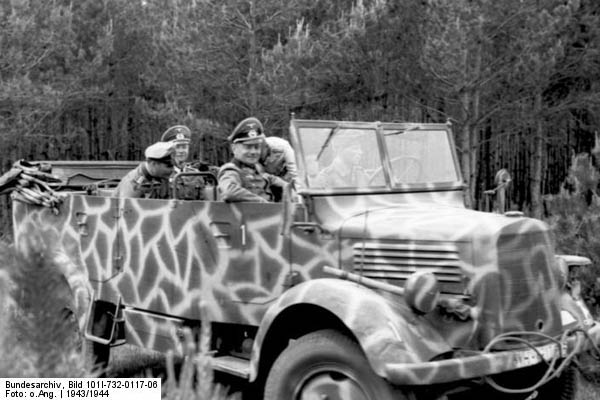 This is another example of Dunkelgelb RAL 7028 painted over the dark-grey base colour as a camouflage colour. This known photo illustrates a Mercedes-Benz L 1500 A personnel carrier of Panzergrenadier-Division Großdeutschland. (Photo: German federal archive via Wikimedia Commons; License: Creative Commons BY-SA-3.0-gb) This is another example of Dunkelgelb RAL 7028 painted over the dark-grey base colour as a camouflage colour. This known photo illustrates a Mercedes-Benz L 1500 A personnel carrier of Panzergrenadier-Division Großdeutschland. (Photo: German federal archive via Wikimedia Commons; License: Creative Commons BY-SA-3.0-gb)
|
|
|
|
|
|
|
|
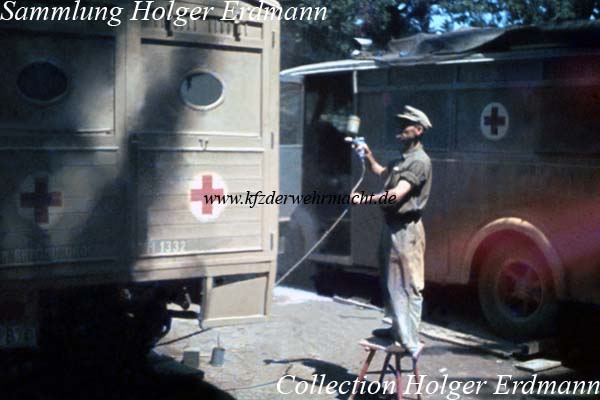 Beginning in February 1943, the dark-yellow colour was applied by the factories. This soldier applied a camouflage finish to a Fiat 626 ambulance with a spray gun. The vehicle was most probably painted in dark-yellow RAL 7028. Beginning in February 1943, the dark-yellow colour was applied by the factories. This soldier applied a camouflage finish to a Fiat 626 ambulance with a spray gun. The vehicle was most probably painted in dark-yellow RAL 7028.
|
|
|
|
|
|
|
|
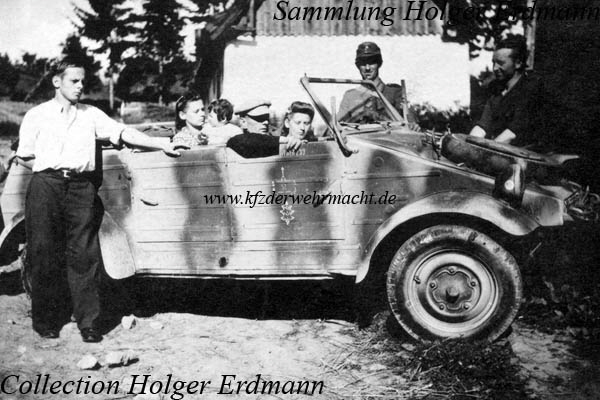 This VW type 82 had a coating of Dunkelgelb RAL 7028. The camouflage finish consisted of broad stripes of Olivgrün RAL 6003 with borderings of Rotbraun RAL 8017. Note the properly applied tactical markings and the division sign of 1. Panzer Division. This VW type 82 had a coating of Dunkelgelb RAL 7028. The camouflage finish consisted of broad stripes of Olivgrün RAL 6003 with borderings of Rotbraun RAL 8017. Note the properly applied tactical markings and the division sign of 1. Panzer Division.
|
|
|
|
|
|
|
|
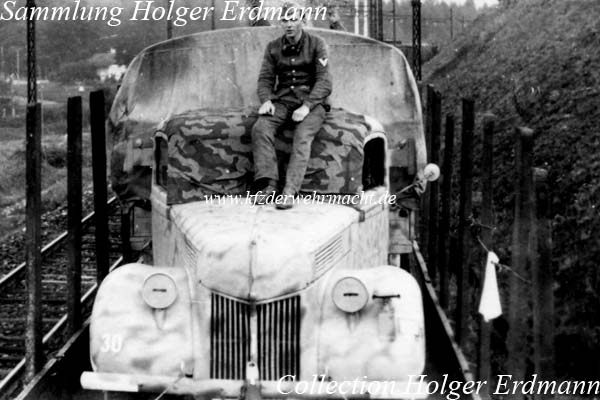 This camouflage pattern on a Ford V 3000 S This camouflage pattern on a Ford V 3000 S
is only one example for the multiplicity of possible camouflage patterns.
|
|
|
|
|
|
|
|
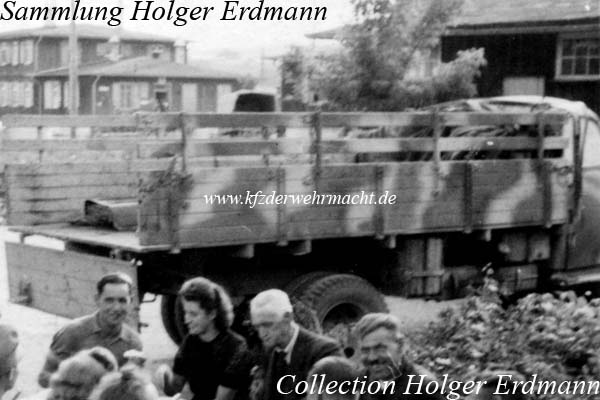 This Borgward B 3000 shows a more solid camouflage pattern consisting of olive-green stripes with red-brown outlines over the dark-yellow base colour. This Borgward B 3000 shows a more solid camouflage pattern consisting of olive-green stripes with red-brown outlines over the dark-yellow base colour.
|
|
|
|
|
|
|
|
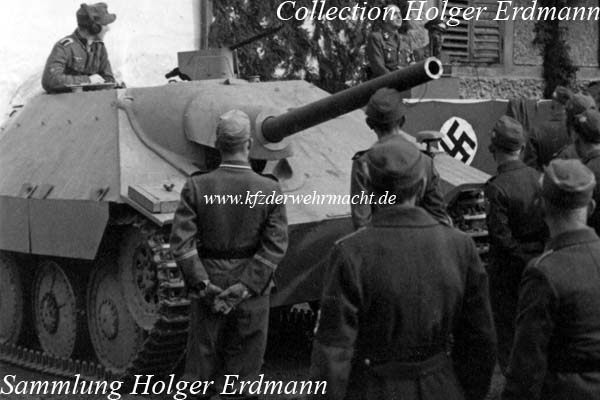 At first sight, this Jagdpanzer 38 of the August 1944 production appears to be painted unicoloured in dark-yellow. But on the lower nose plate one can clearly see a camouflage pattern of at least two colours. This effect is caused by dust and/or sunlight. At first sight, this Jagdpanzer 38 of the August 1944 production appears to be painted unicoloured in dark-yellow. But on the lower nose plate one can clearly see a camouflage pattern of at least two colours. This effect is caused by dust and/or sunlight.
|
|
|
|
|
|
|
|
Based on an order from the O.K.W. W.A. J. Rü 6/VIII from 19th August 1944, all armoured vehicles had to be painted in a three colour camouflage pattern already by the factories. If this system was used in the case of not armoured vehicles at this time is questionable. Most probably, these practice was done by some manufacturers already in late August. In the following time, the factories got Anstrich-Muster (coating patterns) each three per vehicle type. Most probably in September or October 1944, a so called Sparanstrich (economic coating) was introduced. Until this time, the whole vehicle was first completely painted in Dunkelgelb RAL 7028 and the camouflage colours were applied afterwards. Now the camouflage colours were painted directly onto the red anti-corrosive paint RAL 8012 – 1/3 Dunkelgelb RAL 7028, 1/3 Olivgrün RAL 6003 and 1/3 Rotbraun RAL 8017. So, about 2/3 dark-yellow paint could be saved.
First in October 1944, a new colour chart with the hue Dunkelgelb RAL 7028, Ausgabe 1944 (dark-yellow RAL 7028, version 1944) was made. The new hue was darker and slightly greenish. The change was necessary because the hue Dunkelgelb RAL 7028 did not prove well in Central Europe and therefore losses due to straffers became more frequent. Because many of the manufacturers had more or less large stocks of the older hue Dunkelgelb RAL 7028 the change to the new hue occured not to a coherent date. Anyhow, the introduction of Dunkelgelb RAL 7028, Ausgabe 1944 could be proven on exhibits of this time period.
|
|
|
|
|
|
|
|
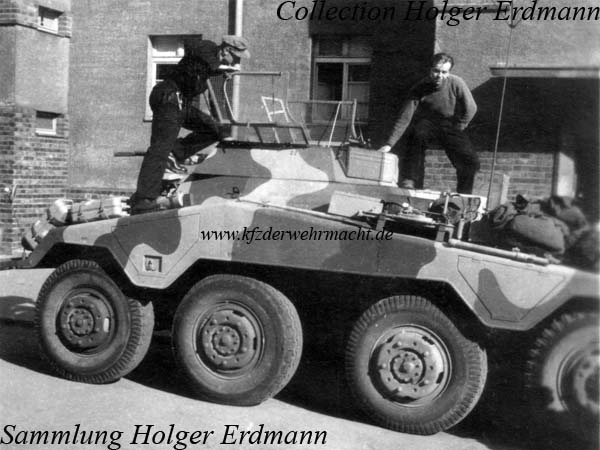 This solidly applied camouflage pattern on this schwerer Panzerspähwagen (2 cm) (Sd. Kfz. 234/1) is for sure a factory applied camouflage pattern introduced in September 1944. The brightest tone corresponds to Dunkelgelb RAL 7028, the middle tone to Olivgrün RAL 6003 and the darkest tone to Rotbraun RAL 8017. This solidly applied camouflage pattern on this schwerer Panzerspähwagen (2 cm) (Sd. Kfz. 234/1) is for sure a factory applied camouflage pattern introduced in September 1944. The brightest tone corresponds to Dunkelgelb RAL 7028, the middle tone to Olivgrün RAL 6003 and the darkest tone to Rotbraun RAL 8017.
|
|
|
|
|
|
|
|
Based on a regulation from the Oberkommandos des Heeres, which was published in the H.V.Bl. 1945 Teil B, Blatt 4 from 12th February 1945, No 52 (O.K.H., 24th January 1945 - 70 k 10/10 - WaA/Wa Chef Ing 1/V), it was ordered that Olivgrün RAL 6003 was to be used as the new base colour. This new base colour was most probably introduced only for armoured vehicles and tanks. Possibly, some manufacturers introduced the olive-green base colour before January 1945. Equipment, which should receive a camouflage coat, should still be painted in each 1/3 Dunkelgelb RAL 7028, Augabe 1944, Olivgrün RAL 6003 and Rotbraun RAL 8017. The camouflage pattern should be made based on a Tarnbild (camouflage master) which was sent to the companies by the army ordnance office. The dark-yellow base coat was prohibited for mayor items of equipment, which was transported on open rail wagons. However, the delivery of equipment should not be interrupted due to missing olive-green colour.
All possible variants of camouflage patterns appeared in the last weeks of war. One had to use the colours which were available. In the last days of war, vehicles in the red anti-corrosive paint with or without camouflage colours were possibly delivered, too.
|
|
|
|
|
|
|
|
- - - - - - - - - - - - - - -
|
|
|
|
|
|
|
|
<< back to camouflage finish
|
|
|